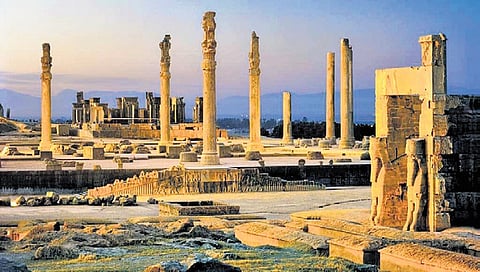

ChatGPT, Llama, Microsoft Copilot, Claude—broad-spectrum, general-purpose AI tools that try to mimic human capabilities—get top billing in the press. They are indeed amazing, but their uses not so—summarising product reviews on Amazon, drafting indifferent art from verbal instructions, making up recipes from pictures of food and helping students write unremarkable essays. But the future of AI is more likely to be specialised machines for specific purposes. They will be apps or tools rather than intelligences, to be used in various sectors for pattern recognition at scales that the human mind cannot attempt.
For instance, while the Rosetta stone approach to decoding continues, AI is behind two projects to decipher lost languages like the writing system of the Indus Valley civilisation, and to decode a huge administrative archive found by Chicago University’s Oriental Institute in 1933 in the ruins of Persepolis, the ceremonial capital of the Achaemenid empire.
DeepScribe is a joint project by the Oriental Institute and the Department of Computer Science at the University of Chicago, where the clay tablets, written mostly in cuneiform in the Elamite language, were photo-archived. Both language and script are known, but there are about 25,000 fragments, which would take thousands of man-hours to process. The project will train an AI on material already deciphered over about 80 years, to translate and catalogue what remains unanalysed. The larger objective is to develop a tool that can be applied to other undeciphered scripts and unknown languages, like the epigraphy of the Indus Valley civilisation.
The Achaemenid empire was ended in 330 BC by Alexander of Macedon, who burned Persepolis to the ground. Ironically, fire may have preserved the tablets for posterity. The documents track the management of food in the empire by an agency like a civil supplies ministry. Being an essential service, its record covers homes of every class, from commoners to emperors. Once it is completely translated, this record could provide new insights into society in Iran about 500 BC, shortly after the founding of Persepolis, which are often masked or invisible in texts of high culture.
Meanwhile, after decades of intensive efforts by scholars like Iravatham Mahadevan and Asko Parpola, the Indus script remains untranslated, and there is not even agreement among researchers about whether the characters seen on seals represent a language or are more like pictograms—perhaps trademarks or brands—or symbols that had meaning in commerce. In 2009, a project by University of Washington computer scientist Rajesh Rao had found that sequences of the script had the same cadence as the grammar of modern spoken languages. However, the fragments are so short that consensus is still elusive.
Last month, a project titled ‘Ancient Script Digitization and Archival of Indus Valley Artifacts using Deep Learning’ started to not attempt to solve the Indus script problems, but to set it up so others can try to solve it. Like the Persepolis project, this one also looks for patterns in about 1,000 images of Harappan seals. The difference is obvious: machine learning depends on huge volumes of data to train on, and the data from Persepolis is about 25 times the volume of data from Harappa. The latter is also more remote in time; absolutely nothing is known about the script or the language it encodes. But the prize would be huge, opening the door to a complete understanding of one of the world’s oldest riverine civilisations. It’s also politically fraught, and would sharpen the battle over the fiction of ‘authentic’ Indian identity.
Meanwhile, researchers at the University of Cologne have used the old-fashioned way to partially decipher the ‘unknown Kushan script’, one of the official languages of the Kushan empire, which propelled Buddhism out of India into the world. The script was discovered over 70 years ago but has remained undeciphered. Several short inscriptions were found in Tajikistan, Afghanistan and Uzbekistan, but remained inscrutable.
Decipherment was achieved following the discovery of two Rosetta Stones—a trilingual text in Gandhari, Bactrian and ‘unknown Kushan’ in Afghanistan and a bilingual one in Bactrian and ‘unknown Kushan’ near Dushanbe. However, the decipherment is only partial and took decades after the script was encountered. Perhaps handing over part of the problem to AI could speed up the job.
Specialised AI and machine learning tools will soon be everywhere. The decipherment of ancient scripts, hitherto the province of language specialists, cryptologists and puzzle fiends, is a fairly obscure area in human knowledge, but AI has enormous scope even here. AI tools will have great applications in mainstream pursuits where volumes of data are involved, like medicine. Clinicians and researchers rely as much on statistics as on physics and chemistry to steer both individual treatment and mass health campaigns, and machines are getting better than humans at some of the work leading to diagnosis and planning treatment. Radiological tools, for instance, are impressive at reading X-ray images. And simulators for inserting dental implants make the process very accurate.
Elsewhere, AI would be useful in managing flow problems, which requires dynamic response. Green-lighting automobile traffic (drivers encounter only one red light on a route) has been a target of automation from the 1980s, to reduce congestion and air pollution. It is done using feedback loops, but AI would make it more responsive to changing traffic patterns. Such limited, specialised applications would bring AI to almost all sectors of economy. They would be more useful than general intelligence, and would not raise fears of machines gaining independence and surpassing humans.
(Views are personal)
(Tweets @pratik_k)
Pratik Kanjilal | For years, the author has been speaking easy to a surprisingly tolerant public